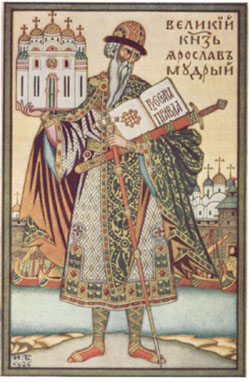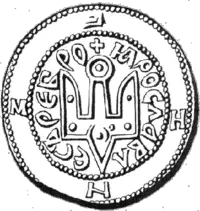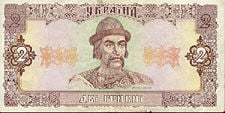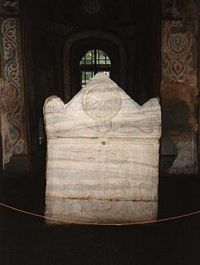Yaroslav I the Wise
Yaroslav I the Wise (c. 978 in Kiev - February 20, 1054 in Kiev) (East Slavic: Ярослав Мудрый; Christian name: George; Old Norse: Jarizleifr) was thrice Grand Prince of Novgorod and Kiev, uniting the two principalities for a time under his rule. During his lengthy reign, Kievan Rus' reached a zenith of its cultural flowering and military power.
His way to the throne
Little is know about the aarly years of Yaroslav's life. He was one of the numerous sons of Vladimir the Great (who was canonized for his role in the Christianization of Kiev), presumably his second by Rogneda of Polotsk, although his actual age (as stated in the Primary Chronicle[1] and corroborated by the examination of his skeleton in the 1930s) would place him among the youngest children of Vladimir. It has been suggested that he was a child conceived out of wedlock after Vladimir's divorce with Rogneda and his marriage to Anna Porphyrogeneta, or even that he was a child of Anna Porphyrogeneta herself. Yaroslav figures prominently in the Norse Saga's[2] under the name of Jarisleif the Lame; his legendary lameness (probably resulting from an arrow wound) was corroborated by the scientists who examined his relics.
In his youth, Yaroslav was sent by his father to rule the northern lands around Rostov the Great but was transferred to Novgorod the Great, as befitted a senior heir to the throne, in 1010. While living there, he founded the town of Yaroslavl (literally, Yaroslav's) on the Volga. His relations with father were apparently strained, and grew only worse on the news that Vladimir bequeathed the Kievan throne to his younger son, Boris. In 1014 Yaroslav refused to pay tribute to Kiev and only Vladimir's death prevented a war.
During the next four years Yaroslav waged a complicated and bloody war for Kiev against his half-brother Sviatopolk, who was supported by his father-in-law, Duke Boleslaus I of Poland. During the course of this struggle, several other brothers (Boris and Gleb, Svyatoslav) were brutally murdered. The Primary Chronicle accused Svyatopolk of planning those murders, while the Saga of Eymund[3] is often interpreted as recounting the story of Boris's assassination by the Varangians in the service of Yaroslav. However, the victim's name is given there as Burizlaf, which is also a name of Boleslaus I in the Scandinavian sources. It is thus possible that the Saga tells the story of Yaroslav's struggle against Svyatopolk (whose troops were commanded by the Polish duke), and not against Boris.
Yaroslav defeated Svyatopolk in their first battle, in 1016, and Svyatopolk fled to Poland. But Svyatopolk returned with Polish troops furnished by his father-in-law Duke Boleslaus of Poland, seized Kiev and pushed Yaroslav back into Novgorod. In 1019, Yaroslav eventually prevailed over Svyatopolk and established his rule over Kiev. One of his first actions as a grand prince was to confer on the loyal Novgorodians (who had helped him to regain the throne), numerous freedoms and privileges. Thus, the foundation for the Novgorod Republic was laid. The Novgorodians respected Yaroslav more than other Kievan princes and the princely residence in the city, next to the marketplace (and where the veche often convened) was named the Yaroslavovo Dvorishche after him. It is thought that it was at that period that Yaroslav promulgated the first code of laws in the East Slavic lands, the Yaroslav's Justice, better known as Russkaya Pravda.
His reign
Leaving aside the legitimacy of Yaroslav's claims to the Kievan throne and his postulated guilt in the murder of his brothers, Nestor and later Russian historians often represented him as a model of virtue and styled him the Wise. A less appealing side of his personality may be revealed by the fact that he imprisoned his younger brother Sudislav for life. Yet another brother, Mstislav of Tmutarakan, whose distant realm bordered on the Northern Caucasus and the Black Sea, hastened to Kiev and inflicted a heavy defeat on Yaroslav in 1024. Thereupon Yaroslav and Mstislav divided Kievan Rus: the area stretching left from the Dnieper, with the capital at Chernihiv, was ceded to Mstislav until his death in 1036.
In his foreign policy, Yaroslav relied on the Scandinavian alliance and on rapprochement with the Byzantine Church to build up strategic alliances. Dowley credits him with cemementing the bonds between the Russian and Byzantine Church, commenting that he acknowledged the Patriarch of Constaninople as overseer of the Russian Church and that for most of the next four centuries "the head of the Russian Church was a Greek" appointed from Constantinople. page 317.</ref> Evans says that he used marriages "of himself and of his children" to strenghten relations with "Sweden, Hungary, Norway, Poland, Byzantium and Germany adding that this was "European integration at its best."[4] In 1030 he reconquered from the Poles Red Rus, and concluded an alliance with king Casimir I the Restorer, sealed by the latter's marriage to Yaroslav's sister Maria. In another successful military raid the same year, he conquered the Estonian fortress of Tarbatu, built his own fort in that place, which went by the name of Yuriev (after St George, or Yury, Yaroslav's patron saint) and forced the surrounding province of Ugaunia to pay annual tribute.
In 1043 Yaroslav staged a naval raid against Constantinople led by his son Vladimir and general Vyshata. Although the Rus' navy was defeated, Yaroslav managed to conclude the war with a favourable treaty and prestigious marriage of his son Vsevolod to the emperor's daughter. It has been suggested that the peace was so advantageous because the Kievans had succeeded in taking a key Byzantine possession in Crimea, Chersones.
To defend his state from the Pechenegs and other nomadic tribes threatening it from the south he constructed a line of forts, composed of Yuriev, Boguslav, Kaniv, Korsun, and Pereyaslav. To celebrate his decisive victory over the Pechenegs in 1036 (who thereupon never were a threat to Kiev) he sponsored the construction of the Saint Sophia Cathedral in 1037. Other celebrated monuments of his reign, such as the Golden Gates of Kiev, have since perished.
Patron of Learning
Yaroslav was a notable patron of book culture and learning. Almost all the "urban population was literate".[5] He is credited with establishing a legal code, known as Russian Truth which drew on "Russian customs, Scandinavian dynastic rules and Byzantine laws and hence, had a truly international character."[6] (In 1051, he had a Russian monk Ilarion proclaimed the metropolitan of Kiev, thus challenging old Byzantine tradition of placing Greeks on the episcopal sees. Ilarion's discourse on Yaroslav and his father Vladimir is frequently cited as the first work of Old Russian literature. He built the Cathedrl of St. Sophia as his metropolitan's seat. Prokofieff, who describes Yaroslav as one of the most cultured men in Europe at the time speaking several European "and even classical languages" says that he founded a school for translating texts from Latin, Greek, Ancient Hebrew and Syrian and that under his rule Kieve developed into one of the "most spiritually developed and enlightened European states."[7] In 1037, Yaroslav dedicated the Ukraine to Mary, Mother of God (Theotokos) and "ever since, she has been revered as Queen of the Ukraine."[8] His father had baptized the whole nation in 988C.E. in what has been described as the "probably the most influential event in Kiev's history."[9]
Family life
In 1019, Yaroslav married Ingegerd Olofsdotter, daughter of the king of Sweden, and gave Ladoga to her as a marriage gift. There are good reasons to believe that before that time he had been married to a woman named Anna, of disputed extraction.
In the Saint Sophia Cathedral, one may see a fresco representing the whole family: Yaroslav, Irene (as Ingigerd was known in Rus), their five daughters and five sons. Yaroslav married three of his daughters to foreign princes who lived in exile at his court: Elizabeth to Harald III of Norway (who had attained her hand by his military exploits in the Byzantine Empire); Anastasia of Kiev to the future Andrew I of Hungary, and the youngest daughter Anne of Kiev married Henry I of France and was the regent of France during their son's minority. Another daughter may have been the Agatha who married Edward the Exile, heir to the throne of England and was the mother of Edgar Ætheling and St. Margaret of Scotland.
Yaroslav had one son from the first marriage (his Christian name being Ilya), and 6 sons from the second marriage. Apprehending the danger that could ensue from divisions between brothers, he exhorted them to live in peace with each other. The eldest of these, Vladimir of Novgorod, best remembered for building the Saint Sophia Cathedral in Novgorod, predeceased his father. Three other sons—Iziaslav, Sviatoslav, and Vsevolod—reigned in Kiev one after another. The youngest children of Yaroslav were Igor of Volynia and Vyacheslav of Smolensk. Prokofieff comments that Yaroslav was connected with "virtually all the courts of Europe at the time."[10]
Legacy
Yaroslav's rule is especially significant in positioning the Russian Church within Orthodoxy. The year of his death is "regarded as marking the final rupture between the Latin and Greek Churches (1054)" and the Russians "quickly learned to despise the Catholics as 'heretics'."[11]Yaroslav's rule is regarded as one of the high points of Kiev history. For the next several centuries, the state was one of the largest and wealthiest in Europe. It was due to internal conflict that the Mongols were able to conquer the state in 1237. However, Yaroslav who standardized the law, promoted learning and patronized, as had his father, the Church, did much to create the conditions that enabled the people of Kiev to enjoy almost two centuries of peace prosperity and stability after his death. Evans comments that by uniting the people through a new "state religion" and a "universal law" the foundation was laid for Kiev to continue to advance "throughout the 11th century."[12] Adopting Christianity as a mechanism to nurter a common identity was a deliberate decision. Yaroslav's father noticed how states with organized religions used this to further their empires through allinances with co-religionists. He is said to have considered adopting Islam but disllkied the prohibition on alcohol, to have rejected Judaism because he thought it had too many restrictions and to have finally settled on Christianity. Yaroslav continued to build on this legacy by strengthening alliances with other Christian states, especially Byzantium with which his father had excellent relations, having married a daughter of the Emperor.[13] Father and son were both interested in integration with other empires, rather than in becomming a stand-alone power. As well as his father, two of his brothers were also canonized, both because of their refusal to abandon their "Christian vow of peace." Conversion to Christianity may have been for mainly political reasons but at root adoption of a state religion was intended to create the conditions of peace and stability so that culture and spiritual development could flourish.
Notes
- ↑ The Chronicle is an account of the history of Kiev from 850 to 1110 compiled in 1113. It is also known as the Tale of Bygone Years. See Ostrowski, Donald.2003. Povest' vremennykh let. Harvard University. Text is in Cyrillic but introductory segments are in English. Retrieved August 3, 2008.
- ↑ Sagas written between the 13th and 14th centuries, see Icelandic Saga Data Base Sagadb.org. Retrieved August 3, 2008.
- ↑ Hermann Pálsson, and Paul Geoffrey Edwards. 1989. Vikings in Russia: Yngvar's saga and Eymund's saga. Edinburgh: Edinburgh University Press. ISBN 9780852246238.
- ↑ Evans, page 17.
- ↑ Prokofieff, page 446.
- ↑ Prokofieff, page 447.
- ↑ Prokofieff, page 446 N 39.
- ↑ Connell, Janice T. 1995. Meetings with Mary: visions of the Blessed Mother. New York: Ballantine Books. ISBN 9780345391247. pages 267-268.
- ↑ Evans, page 110
- ↑ Prokofieff, page 446.
- ↑ Dowley, page 317.
- ↑ Evans, page 110.
- ↑ Evans, page 17.
ReferencesISBN links support NWE through referral fees
- Dowley, Tim. 1995. Introduction to the history of Christianity. Minneapolis: Fortress Press. ISBN 9780800629359
- Evans, Andrew. 2007. Ukraine, 2nd: The Bradt Travel Guide. London: Bradt Travel Guide. ISBN 9781841621814
- Kocherha Ivan. 1984. Yaroslav: the wise. NY: Firebird Pubns. ISBN 9780828526999
- Martin, Janet. 1995. Medieval Russia, 980-1584. Cambridge: Cambridge University Press ISBN 0-521-36276-8
- Prokofieff, Sergei. O. 1993. Spiritual Origins of Eastern Europe. London: Temple. ISBN 9780904693553
- Roesdahl, Else. 1999. The Vikings. NY: Penguin. ISBN 978-0140252828
- Kocherha, Ivan Antonovych, and Walter May. 1982. Yaroslav the Wise: a drama in verse. Kiev: Dnipro.
External links
| Preceded by: Sviatopolk I |
Prince of Kiev and Novgorod | Succeeded by: Iziaslav |
Credits
New World Encyclopedia writers and editors rewrote and completed the Wikipedia article in accordance with New World Encyclopedia standards. This article abides by terms of the Creative Commons CC-by-sa 3.0 License (CC-by-sa), which may be used and disseminated with proper attribution. Credit is due under the terms of this license that can reference both the New World Encyclopedia contributors and the selfless volunteer contributors of the Wikimedia Foundation. To cite this article click here for a list of acceptable citing formats.The history of earlier contributions by wikipedians is accessible to researchers here:
The history of this article since it was imported to New World Encyclopedia:
Note: Some restrictions may apply to use of individual images which are separately licensed.




